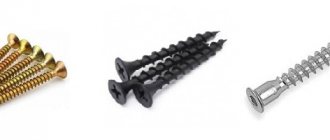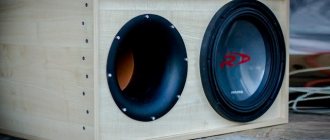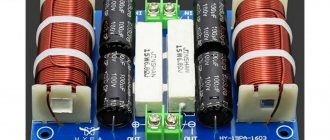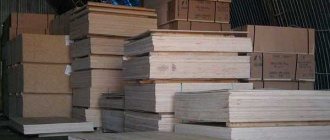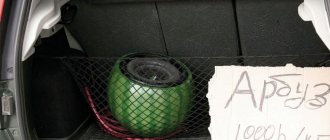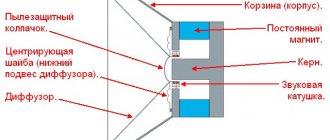How to calculate the volume and size of a box for a subwoofer is a task that anyone who plans to make a low-frequency sound system with their own hands will have to solve. The main parameter when calculating the volume of a future low-frequency speaker is the diameter of the loudspeaker. The speaker diffuser creates a certain air pressure. Air waves must propagate without interference in the internal volume of the speaker system.
If the box is too small, then many reflected waves in antiphase will appear inside the column, which will cancel each other out. This will negatively affect the sound quality. The bass will be dry and hard. If the volume of the box is too large, a reverberation effect will appear in it and the bass will be booming, but “smeared”. Therefore, it is necessary to calculate the volume of the subwoofer by speaker.
How to calculate the volume of a subwoofer box
To calculate the displacement of a box for a subwoofer, you need to choose the design of a low-frequency device. Powerful low-frequency systems are divided into three groups:
- Closed case
- Bass reflex
- Bandpass
A closed box is the easiest to make. It can have the shape of a cube, rectangular parallelepiped or trapezoid with a beveled front or back wall. The closed box, in its dimensions, is smaller than other structures. A reduction in volume, while maintaining acoustic characteristics, is achieved by filling the internal space with some kind of damping material. Correctly calculating a subwoofer with a closed box is quite simple. It has only one characteristic, volume. Even an untrained amateur can cut blanks for the “closed box” design from the appropriate material.
Despite many advantages, the closed box has one significant drawback. This is the lowest efficiency of all designs. In order to get maximum sound quality from a closed box, the speaker needs to be loaded as much as possible. Only in this case the acoustic characteristics of the product will be at a high level. You can calculate the box for a closed subwoofer based on the diameter of the speaker.
- 8 inches – 10-12 liters
- 10 inches –13-25 liters
- 12 inches – 26-36 liters
- 15 inches – 38-58 liters
The larger the speaker diameter, the greater the volume dispersion. Calculating the volume of a subwoofer for powerful speakers is more difficult than for compact products. This is due to the individual characteristics of different models.
How to calculate phi box for a subwoofer
A phi or a box with a bass reflex uses, to improve acoustic characteristics, the reverse stroke of the speaker cone, or rather the air wave that is formed in this case. When calculating a subwoofer in liters, an adjustment is made for the thickness of the material and only the internal volume is taken into account. The internal space of the structure communicates with the surrounding atmosphere through a special port or tunnel, which contains a certain air volume. This part of the box is called the bass reflex. Its dimensions are selected in such a way that the energy of the diffuser's reverse stroke is transferred to the surrounding space in phase with the air wave of the diffuser's forward stroke. This effect is achieved in a narrow frequency range and increases the efficiency of the speaker system. The bass reflex can have a slot or tunnel design and can be tuned to a specific frequency. The principle of its operation depends on this.
Correctly calculating the volume of a box for a subwoofer with a slot bass reflex is more difficult than for a closed box. The bass reflex design itself has more parts, the dimensions of which are selected based on the type of speaker. You can calculate the box for the subwoofer based on the size of the loudspeaker.
- 8 inches – 20-35 liters
- 10 inches – 35-45 liters
- 12 inches – 46-76 liters
- 15 inches – 78-120 liters
Here, like a closed box, there is an acceptable variation in volume. This allows you to experiment when making a speaker with your own hands, achieving the most natural sound of low frequencies. You can choose a subwoofer housing from scrap materials. The main thing is to respect the dimensions of the bass reflex.
The disadvantage of a slot bass reflex is that it is configured once during manufacture and then its parameters cannot be changed. In this regard, a tunnel bass reflex is more convenient. It is a box with a hole in one of the walls. A plastic glass or tube, which consists of two parts, is attached to this hole. They can move into one another, changing the bass reflex tuning frequency. Correctly calculating the volume of the box for a subwoofer is possible only taking into account the resonant frequency of the dynamic head and other parameters. Often, the speaker passport indicates the volume of the speaker recommended by the manufacturer.
Properties of homemade models
Many music lovers want to bring their sound to a super powerful level. In this case, the speakers should be equipped with a subwoofer. The sound will become tens of times stronger.
Low frequencies differ from high and mid frequencies in that they do not need to be sounded in stereo. And there is no need to make two speakers in a wideband version.
It is only important to choose:
- Speakers, one of the expensive elements;
- Powerful microcircuits that amplify sound;
- One hundred watt pulse power supply.
All remaining spare parts are of low cost. If you do your work efficiently, you can assemble the column yourself. Homemade devices can work for several years. Only microcircuits, diodes and transistors fail.
How to calculate and calculate the volume of a subwoofer enclosure
A bandpass or bandpass system is an acoustic high- and low-pass filter. The design comes in fourth and sixth order. The acoustic low-frequency system consists of two sections, each of which is equipped with a bass reflex. The sections are divided into two volumes by a partition on which a loudspeaker is installed. The front and rear planes of the diffuser operate in their own space. A speaker with two volumes and one bass reflex is a fourth-order bandpass, and a system with two bass reflexes is a sixth-order bandpass. Calculating the box for a subwoofer of a bandpass system will be the most difficult. When calculating the displacement of a subwoofer, not only the size of the speaker is taken into account, but also the cutoff frequencies of the acoustic filters.
Plywood
Wood has been used to make furniture since ancient times, but it was a time when wood was available in abundance, and as wood scarcity increased, plywood was invented for those who could not afford teak, walnut or mahogany furniture. Plywood is made from wood, but every piece of wood is used to minimize wood loss. Plywood has many advantages, such as a variety of sizes and thicknesses. It can easily be covered with paint or laminate in any color or pattern. Plywood production minimizes wood waste, but does not eliminate it.
MDF is an abbreviation for medium density fiberboard. Since the shortage of wood prompted the invention of plywood, MDF is another product that was invented as a wood substitute. MDF is made up of small pieces of wood that are broken down into wood fibers and then compressed in a hydraulic press under very high pressure into a board. MDF boards are manufactured in various thicknesses so that they can be easily used in various industries. These slabs have a very smooth surface and the furniture they make is of very high quality in terms of attractiveness. MDF is easily laminated in a variety of shapes and colors, or painted to your choice. MDF boards are made from wood fibres, hence they have very little screw-driving capacity.
How to calculate a box for a subwoofer
The easiest way to calculate the size of the subwoofer is if it is made in the form of a closed box. There is no bass reflex or acoustic filters and the recommended volume is calculated based on the diameter of the speaker. In order to calculate liters for a subwoofer, simply multiply the width, height and depth of the box. You need to keep in mind that speakers of the same diameter, but from different manufacturers, will sound differently. This makes it difficult to independently calculate a low-frequency acoustic system. How the subwoofer box is calculated. You should know that only the “clean” internal volume is taken into account.
Self-calculation does not take into account the type of speaker, its resonant frequency and the output power of the low-frequency amplifier. All these factors influence the dimensions of the subwoofer box. If difficulties arise during the work, it is better to use simple computer programs to perform calculations. The most commonly used programs are:
- JBL Speaker shop
- BassBox 6 Pro
- UniBox
JBL Speaker shop includes two utilities. Enclosure Module allows you to design a box for a sound system, taking into account an existing speaker, or select a loudspeaker to fit a ready-made enclosure. In the program you can calculate a closed box, a bass reflex system, or calculate a box for two subwoofers. Among the parameters needed to correctly calculate a woofer, the program takes into account the manufacturer, model number and resonant frequency. The entire list of parameters used to accurately calculate the future design includes more than ten items. Once the parameters are entered, you can select any type of housing. For a specific speaker, the program demonstrates a closed box, bass reflex or bandpass, indicating the advantages and disadvantages of each system. For beginners in acoustics, there is a training file with visual examples of calculations. The Crossover Module utility allows you to calculate all the parameters of a crossover filter for any acoustic system.
Do-it-yourself bookshelf acoustics
One day I decided to build myself high-quality acoustics for sounding a small room, as well as for use as near-field monitors when working with sound on a computer (hobby). The main requirement is adequate sound in relation to the source. It’s not so much that “the lows are wobbling” or that “the cymbals are ringing,” but rather an adequate natural sound. So, we collect high-quality “shelf holders”.
Number of lanes
In theory, the ideal system is single-band. But, like everything ideal, such a system does not exist in nature. Yes, there are very high-quality broadband speakers from the same "Visaton", but for some reason all well-known manufacturers make two-way bookshelf systems. And when it comes to the floor option, then 3 stripes are not uncommon. There wasn’t much of a question here – the classic two-band version: low-frequency and high-frequency.
Speaker selection
The main requirement for speakers is an optimal price/quality ratio. Those. it shouldn’t be “cheap” for 500 rubles, but also not a mind-blowing “high-end” for $1000. Besides, I was in no hurry. The idea of assembling “shelf speakers” with my own hands came quite a long time ago, and I threw the bait in advance to my good friend, “sick” with sound, with whom we have been constantly and fruitfully communicating on this topic for a long time.
The first to appear was the RF - Vifa XT19SD-00/04 ring-rad. These are high-quality 4-ohm tweeters, quite popular among audiophiles. They were planned for one set, but for some reason they didn’t work out and ended up in my set.
LF arrived second. They turned out to be very decent midbass from the Soundstream Exact 5.3 kit. Here you can read a little about them. It so happened that the tweeters burned out during installation, and the lone woofers themselves turned out to be unnecessary. 4 ohm 5.5″ midbass mounted in a cast aluminum basket was immediately purchased.
Now that you have the speakers, you can start creating acoustics.
Active / passive?
Each option has its pros and cons. Firstly, you need to take into account the compactness of the speakers themselves and the associated difficulties in layout in limited space. There is no point in installing it outside. Secondly, individual modules as independent components can be combined in the future, and it is also easier to repair if something happens. And thirdly, active speakers are quite expensive. Because if you make a decent amplifier (and sometimes there is one in each case), then it will turn out to be more expensive than the acoustics themselves. Besides, I already had an amplifier. But in any case, I am in favor of the scheme - passive acoustics + amplifier, it is more universal.
Calculation of housing dimensions
We have decided on the speakers, now we need to understand which housing is optimal for them. Dimensions are calculated based on the sound characteristics of the woofer. There are no recommendations on the manufacturer's website, because... The speaker was intended primarily for car audio. There is no point in keeping special equipment for these purposes unless it is your job. Therefore, a smart guy with a special stand comes to the rescue. As a result of laboratory tests, we obtain a calculated case size of 310 x 210 x 270 mm. During the measurement process, the bass reflex parameters were also calculated.
By the way, many manufacturers publish recommended housing sizes for speakers on their websites. When such information is available, it is logical to use it, but in this case I did not have such data, so I had to do laboratory research.
Housing material
In my opinion, the most optimal material for the case is MDF. It is acoustically neutral and also performs slightly better than chipboard. Plywood is also good, but quality plywood is not easy to find and is more expensive and difficult to process. 22mm MDF sheet was chosen as the source material for the body. In principle, standard 18-20mm is quite enough, but I decided to make a little extra. There is no such thing as too much rigidity.
Housing construction and design
One of the most important stages. Before going for MDF, I advise you to decide on the design so that you can immediately ask the seller to cut the sheet in parts, and at a normal point of sale there are always good machines with accurate and even cuts. It is difficult to obtain such a cut at home.
So, design. The speakers should look at least as good as “industrial” ones, so that there is no feeling of a club of crazy hands. We make not only high-quality, but also beautiful acoustics. In general, there are practically no beautiful, interesting and at the same time structurally simple acoustic systems. Beautiful acoustics are made by the Italian Sonus Faber, stunning in beauty - Magico Mini. But they are all made using precision machines, which, by definition, are not available at home. As an option, you can order the cases from a good “cabinet maker” with hands and CNC. Depending on where and what you order, such work will cost from 10,000 rubles. up to 30,000 rub. along with materials. If the specialist is good, then the speakers will look no worse, or even better, than store-bought ones. In this case, I decided that I would do everything completely myself. Therefore, we look at things realistically and make a design without any bevels, curly cuts, etc. Those. it will be a parallelepiped. The calculated dimensions give a fairly pleasant proportion, and proportion in the design is already half the battle.
What to design in? Although I am related to design by line of work, my knowledge of 3D packages is, to put it mildly, superficial. In this case, the program should be more engineering than rendering. Specialized "Kads" for this purpose are heavy and unnecessary. A solution was found quickly enough - frivolous SketchUp is more than suitable for this purpose. It is so simple and intuitive that I was completely mastered in about an hour. The main thing he can do is quickly create any shapes, set dimensions, use simple textures. I believe that such a program is ideal for “home” purposes. You can easily use it, for example, to design a kitchen or even a small house.
Here is the body design:
The design is simple. Six walls glued to each other. There are 2 cutouts on the front for speakers. There are 2 cutouts at the back: for the bass reflex and for the terminal block. The 120x80 rectangle marks the space for the crossover. Inside, the bass reflex is another wall the width of the internal space, attached perpendicularly under the cutout:
Based on the drawing, a diagram of cutting the sheet emerges:
How will we finish the body? Covering with film was immediately ruled out - the acoustics should look decent. Painting was considered as an option. I abandoned this idea because... Such speakers will not fit into every interior (at least they didn’t fit into the current one). I want more versatility. In this regard, natural veneer is more suitable. But the acoustics, completely covered with veneer, look a bit boring. Search for a combined solution:
In general, the options are not bad in appearance, but purely structurally they cause difficulties. As a result, it was decided to trim the side walls with ash veneer, and cover the remaining 4 walls around the circumference with leather, or rather with high-quality automotive leatherette. The arquebus is beautiful in itself, but the woofer has a structural overlay on the front side of the housing that will not look very nice. Therefore, it was decided to make an additional decorative overlay (ring) for it, which will press it to the body, and at the same time add beauty to the speaker itself. The construction and design have been decided.
Tools
Before moving on to the next stage, I’ll outline what basic tools are needed for the job: - Circular. - Jigsaw. - Drill. - Fraser. — Sanding machine. - Straight arms. Without this kit, it is better to order the cases from a good craftsman.
Sawing
So, we cut the budget MDF sheet. I have already written that it is better to saw on special machines - it is inexpensive, but the results are accurate. But because I decided to make the body myself inside and out, then for the purity of the experiment I sawed it myself with a manual circular saw, and small pieces with a jigsaw with a guide. As expected, the perfect cut did not work out. After the cut, pairs of walls (left-right, front-back, etc.) are installed in pairs, adjusted with a grinder and/or electric planer and checked for perpendicularity with a square. And later during assembly they are finally adjusted after gluing. A loss of 2-3 mm is insignificant. But I still recommend sawing right away “at the base”, you will save a lot of time.
Housing assembly
The walls are glued together with PVA and tightened with screws. First we glue the body without the front wall.
Next, we cut the bass reflex hole with a jigsaw.
Now there is a hole for the terminal block, as well as a chamfer in order to “sink” it. Initially, according to the design, the terminal block was supposed to be placed at the bottom. But during the process, it became clear that mounting the crossover in the center through the hole for the woofer would not be very convenient, so I moved the hole for the terminal block higher, and the place for the crossover lower.
Before “attaching the lid”, it is necessary to cover the insides with vibration-proof material.
You can close the box.
Now one of the very important stages is cutting out the holes for the speakers on the front panel. I have already said that the ideal speaker system is a single-way one. Why? Because sound propagates from one source to the listener without a time mismatch due to the (tiny) difference in distance that occurs when using a multi-band system. Therefore, it is best to place the speakers as close to each other as possible. This makes the sound image “dense.” We calculate the holes so that the distance between the edges of the speakers will be approximately 1 cm. The holes are cut with a jigsaw with a circular guide.
The speakers should be recessed. We apply the speakers and outline the diameter along their edge for chamfering. We measure the depth of the chamfer using the trim of each speaker. The chamfer was removed using a hand router. The cutting depth was set according to the stop. No guides were used; layer by layer was carefully removed in a circular manner to the line. For the “squeaker”, two additional “ears” were cut out for the terminals.
After the chamfers are removed, we attach the terminal block and speakers, and then drill holes for future self-tapping screws with a thin drill. Without them, firstly, the MDF itself may “spread open” when screwing in the screws, and secondly, during the final installation the speakers will be more difficult to position evenly. I thought for a very long time about how to position the speakers relative to each other, and came up with the following scheme:
Screw holes on external surfaces must be repaired before final finishing. I used epoxy. In order not to wait for one surface to harden, I sealed each surface with tape and moved on to the next one. When the epoxy had dried, I sanded it with a sander.
Finishing
The veneer was left over from some ancient times, so there was no need to buy it. The sheets were not wide, so a couple of sheets were selected, fastened with tape and glued to the body. First one side, then the other.
The veneer needs to be protected. I coated it with clear yacht varnish.
Now you need to cover the body with leatherette. There are many options for how to do this. I decided to do it as follows. A strip is cut 20 mm larger than the width of the case and slightly longer than the circumference of the case. On each side it is folded by 10 mm, the hem is glued with “special glue 88”. Then, using the same glue, the strip is glued around the circumference to the body. First the bottom (partially), then the back wall, then the top, then the front and the bottom again. At the last stage before gluing, the strip is cut in place and glued end-to-end. I glued all sides at once, i.e. didn't wait for each side to dry. After each side I took a short break (the glue sets quite quickly) and started on the next one.
After everything has dried, carefully cut and glue the skin on the bass reflex hole inside.
If you really want to, then the phasic can be somehow refined.
Then holes are cut on the terminal block, “woofer” and “tweeter”. The skin on the terminal block and RF will be recessed downwards, so the diameter of the cutout can be left 5-10 mm smaller. The skin on the woofer will be pressed against the decorative ring, so you need to trim it so that it is not visible.
Final editing
First of all, we mount the crossover. The cross is home-made, based on a good element base. Air-core coils, tweeter film capacitors and MOX resistors are used. I didn’t solder it myself, but ordered it from smart guys.
By the way, many manufacturers have the sin of sometimes putting not very good cross-country products into even fairly expensive acoustics. On the Internet you can find many “gutted” systems on this topic. Before installing the cross, you need to solder three pairs of wires: for the terminal block, LF and HF. It turned out that it would have to be mounted directly on a plate with vibration isolation. I thought it was unnecessary and dismantled it. Now you can screw it on. As a backing I used a piece of packaging film from under some device.
Now we solder the required pair of wires to the terminal block and fix it on the body. The terminal block and speakers are screwed on with decorative black self-tapping screws with an asterisk head. The cover on the “squeaks” is screwed with similar screws, so it would be logical to use the same ones for the rest. The back wall is ready.
Before installing the speakers, it is necessary to dampen the housing with a special padding polyester. For these purposes, cotton wool from Visaton was used. The synthetic winterizer is glued around the circumference of the walls.
In principle, it makes no difference which speaker to start with. I started with the squeak. We solder the corresponding pair of wires from the cross, insert the speaker and fasten it with screws. Ready.
The midbass needs to be slipped under the skin, and pressed down on top with a decorative ring. Solder the remaining couple of wires and mount the speaker.
All? All. We screw the acoustic cable to the terminal block and begin testing.
Tests
The system was tested in the following configurations:
1. Receiver Sherwood VR-758R + acoustics.
2. Computer + Unicorn (USB-DAC) + Homemade stereo amplifier + acoustics.
3. Computer + E-mu 0204 (USB-DAC) + Sherwood VR-758R + acoustics.
A little about the configurations themselves. I personally think that at the moment the ideal option for a home music center is: computer + USB DAC + amplifier + acoustics. Digital sound without distortion is captured via USB and sent to a high-quality DAC, from which it is transmitted to a high-quality amplifier and then to the acoustics. In such a chain the amount of distortion is minimal. In addition, you can use completely different soundtracks: 44000/16, 48000/24, 96000/24, etc. Everything is limited by the capabilities of the driver and DAC. Receivers in this regard are a less flexible and obsolete option. The size of modern hard drives allows you to store almost your entire media library on them. And trends towards subscription to Internet content may eliminate this option, although this is not in the near future and is not suitable for everyone.
I will say right away that in all three configurations the acoustics sounded great. To be honest, I didn't even expect it. Here are some subjective aspects.
1. Adequate and natural sound. What is recorded is what is played back. There are no distortions in any direction. Just as I wanted.
2. Greater sensitivity to the source material. All recording flaws, if any, are clearly audible. High-quality mixed tracks are listened to perfectly.
3. Well-readable bass for such sizes. Of course, you can’t fully appreciate organ music on bookshelf speakers (it’s generally difficult to appreciate it on acoustics), but most of the material can be “digested” without problems. It's hard to expect more from such babies.
4. Very good attention to detail. You can hear every instrument. Even with a rich sound image and decent volume, the sound does not turn into a mess (the amplifier plays an important role here).
5. I would like to turn it up louder . The acoustics do not scream, but play smoothly. Although this is also not a small merit of the amplifier itself, because As the load increases, a good amplifier maintains linearity.
6. Long listening does not give you a headache. Personally, this often happens to me, but here it plays all day and nothing happens.
7. Concerns about incorrect panorama and strong dependence of the sound on the position of the listener were not confirmed. As far as I know, car acoustics have a specific sound phasing due to the location of the speakers in the cabin. Namely, I read about this set that its midbass is more universal in this regard. Which was actually confirmed. You can sit in the center in front of the speakers, or stand next to them sideways - the sound is excellent. There is a dependence, but it is very small.
As for the configurations themselves, the highest quality sound was achieved with the second configuration.
Firstly, a very high quality Unicorn DAC was used. You can read about him here.
Secondly, the “home-made amplifier” is the know-how of one smart Tolyatti “sound specialist”. Here it is in a nice little aluminum case:
And here is the “gutted” one:
In a nutshell, we were able to find a circuit solution in which the amplifier retains its characteristics when the volume changes, i.e. does not distort the sound at any (constructively permissible) volume. Many amplifiers (even very expensive ones) suffer from this. It was amazing to hear how such an amplifier brought many speakers to life, i.e. made them sound the way they should sound. By the way, some industrial amplifiers (in particular, the Xindak, which is quite good in itself), were also rebuilt according to this scheme, and they got a “second wind”.
Have you compared acoustics with something else, you ask? Yes, for example, with ProAC Studio 110 – these are quite high-quality bookshelf acoustics, here’s a little about them. We compared them and realized that they definitely sound no worse. The “Proaks” may have a slightly lesser dependence of the sound on the position of the listener due to the specific placement of the inverter and the “tweeter”; somehow they cleverly calculated all this. As for the rest, it’s absolutely no worse, even I personally liked my homemade products better, but we’ll chalk this up to subjectivity. I also put on headphones (quite good Koss) and compared them by panorama, highs and lows. Absolutely identical sound. Even at the bottom. In general, complete delight.
Costing by materials
Mid/bass speakers (pair): 3,000 rub. HF speakers (pair): 3,000 rub. Crossover (pair): 3,000 rub. Sintepon: 160 rub. Terminal (terminal block): 700 rub. Screws: 80 rub. MDF sheet, 22mm: RUR 2,750. Scotch tape: 30 rub. PVA: 120 rub. Special glue 88: 120 rub. Vibration isolation: 200 rub. Figured ring-onlay: 500 rub. Cable: 500r. Total: 14,160 rub.
Some materials were or were received free of charge and accordingly are not taken into account here.
In custody
In any more or less complex device or complete functional system, absolutely everything is important. When it comes to a music system, the final result is influenced by a large number of factors:
— The quality of the phonogram. — A device for playing a phonogram. — Digital-to-analog converter. - Signal amplifier. - Wires. — Speakers installed in the speaker housing. — Correctly designed for speakers and high-quality assembled housings. — Diagram and accessories for the crossover.
This is a basic but not complete list.
It is wrong to think that the main thing is the amplifier, or the main thing is the wires, or the main thing is the speakers. A home music system is like an orchestra. And if in this orchestra some people play poorly and others play brilliantly, then overall the result will be average. Or, as they said in a very precise example: if you mix a barrel of shit with a barrel of jam, you get two barrels of shit.
There is another extreme. A good system costs incredible amounts of money. This means that each component should cost half a million. And phonograms must be exclusively on Super Audio CDs or branded records. Like a closed society of elite audiophiles. This is all bullshit.
I came to the conclusion that it is quite possible to assemble your own relatively budget system, which can be described in one word “Sounds”. And if, due to its specific features, it is better to use real existing solutions as a DAC or amplifier, of which there are a lot now. Then a correctly made (either independently or to order) acoustic system will sound better than a “branded” one purchased for the same money. Nowadays almost all components can be ordered online. Moreover, many manufacturers publish enclosure diagrams for their respective speakers. There is a lot of software for calculating housing parameters. There are many specialized forums online, and offline there are people with hands. Of course, it is impossible to be an expert in everything. As in any field, the main thing is to know the general principles.
The article does not claim to be the ultimate truth, but I hope that my thoughts and my experience will be useful to someone else.
Upd. In the comments, many people ask about the amplifier. If anyone is interested, write in a personal message, I will give the coordinates.
Upd2. The amplifier developer now has his own website - pvd-audio.com)
How to calculate the displacement of a subwoofer housing
To correctly determine the volume of a subwoofer enclosure, you need to take into account one important quantity. This is the transfer function of the car interior. It is defined very simply. You need to multiply the longest seat in the cabin by two and divide the speed of sound in air by this value. If the length is 2 m 45 cm, then the transfer function of the cabin will be equal to 343/4.9 = 70. The interior PFS is the frequency in hertz. This value is entered as a parameter when calculating the subwoofer box using computer programs.
The more parameters are entered into the speaker system design program, the more accurate and correct its volume will be calculated.
Subwoofer volume
How to find out and calculate the volume of a subwoofer in liters. The most labor-intensive calculations will be for structures with a bass reflex or bandpass. Despite the high user parameters, the bandpass design is rarely used in cars. Calculation and production of an acoustic system with a slot bass reflex requires more parts and carpentry work. It is necessary to accurately calculate the area of the bass reflex port, and after manufacturing and assembling the structure, all internal corners must be carefully rounded to avoid air vortex waves. It’s easier to calculate a box for a subwoofer on a pipe.
The pipe is made of plastic and consists of two segments, one of which can move inside the other. Such a device is sold in specialized stores. The movement of the pipe components changes the effective area of the bass reflex, which allows you to tune the structure to a specific frequency.
Which box to choose for a subwoofer is determined by the type of speaker and location of the bass speaker. If the luggage compartment is empty and not used for transporting cargo, then it is best to place a low-frequency speaker system there. If part of the trunk is needed for any purpose, then it is better to choose a closed box, since it has minimal dimensions. When the trunk cannot be used, the bass speaker is mounted on a shelf behind the backs of the rear seats. In this case, the “Free Air” design is selected.
What material is the subwoofer made from?
If you have the choice of MDF or plywood for the subwoofer, then it is better to use plywood. It is stronger than the finely dispersed fraction and is not at all afraid of water. The plywood box can be assembled using any fasteners, since the vibration of the frame will not affect the strength of the structure in any way. The MDF housing is suitable for medium and high power loudspeakers. It is better to make the front wall double, that is, with a wall thickness of 18 mm, the front panel for mounting the speaker should have a thickness of 36 cm. It is recommended to mount the electrodynamic head on embedded elements, and not on self-tapping screws.
